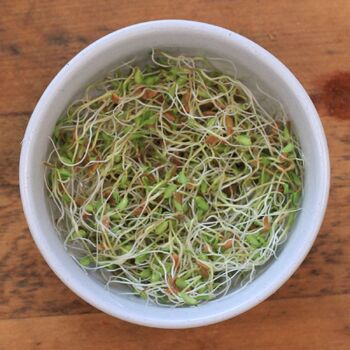How to Grow Linseed Sprouts
How to Grow Linseed Sprouts
Family: Linaceae
Binomial name: Linum usitatissimum
| Best Method | Paper Towel |
| Quantity of seeds to use for a 500ml jar: | 2.5 tbsp (approx 50ml / 20g) |
| Soaking time: | 0 hours |
| Germination temperature: | 18-25°C |
| Day to harvest: | 4-8 days |
How to Grow Linseed Sprouts
Linseed seeds can be sprouted indoors at any time of year.
Sprouting seeds are usually grown indoors in a position away from direct sunlight. Growing the sprouts in the dark will produce sweeter shoots than growing them in a brightly lit position.
Linseed seeds can be sprouted in a sprouting jar or on paper towel. The paper towel method is often more successful for linseed seeds, which have a gelatinous coating and can retain too much water to germinate well in a jar.
- Rinse 2.5 tbsp (approx 50ml / 20g) of seed in a sieve and remove any noticeably damaged or discoloured seeds.
- Wet 3 pieces of paper towel and put them on top of each other flat on a plate.
- Drain the water from the plate. The paper towel should be damp but not wet enough to make seeds float.
- Sprinkle the seeds in a single layer on the paper towel.
- Check the seeds twice a day and water them as needed to stop the paper towel from drying out. Use a mister or spray bottle to wet the seeds, or gently add a small amount of water to the saucer using a small jug or cup, then drain excess water from the plate.
How to Harvest Linseed Sprouts
Linseed sprouts should be ready to harvest in approximately 4-8 days.
Just before harvesting the sprouts, expose them to sunlight for a few hours until the shoots turn green. This step is essential to improve the nutritional benefit of the sprouts.
To harvest the sprouts, gently pull them to separate them from the paper towel. Rinse the harvested sprouts well, discard any unsprouted seeds, and leave sprouts to dry on kitchen paper. Drying the sprouts improves their storage time.
Linseed sprouts are best eaten soon after they are harvested. Sprouts can be stored for three or four days in a sealed container in the refrigerator. Discard immediately if there any signs of mould or any unpleasant smell. Ideally, grow small batches at staggered intervals so you can always eat the sprouts at their freshest.
Common Problems When Growing Sprouts
Like all plants, linseed is susceptible to some pests, diseases and other problems. Below is a list of the most common problems gardeners encounter when growing linseed plants:
- Seeds not sprouting may be caused by having too much or too little water in the jar, overfilling the jar, or seeds having been stored incorrectly prior to use. Use the recommended quantity of seeds and rinse and drain seeds as directed then place the jar on its side so some water is retained; store sprouting seeds in a cool, dry place.
- Smelly or mouldy seeds may be caused by not rinsing the sprouts often enough, high temperatures or mould spores being introduced through using dirty equipment or water. Rinse seeds thoroughly at least twice a day and do not expose jars to temperatures above 30°C. Use thoroughly clean jars and lids; for best results use filtered water to rinse seeds.
- Chewy or bitter tasting sprouts may be caused by exposing the sprouts to too much light while they were growing or leaving sprouts too long before harvesting them. Sprouts can be grown in the dark and only exposed to sunlight for a short while when they are ready to harvest; harvest sprouts when they are small and crisp.

